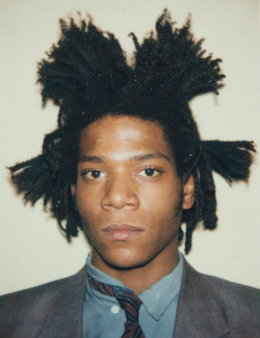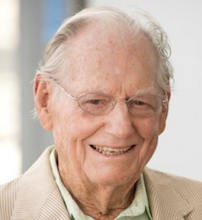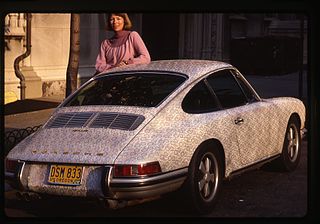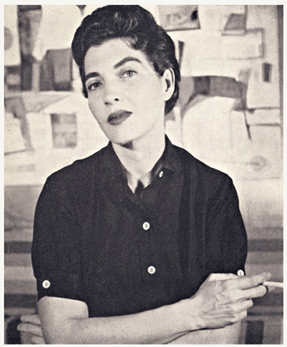Related Research Articles

Jean-Michel Basquiat was an American artist who rose to success during the 1980s as part of the Neo-expressionism movement.

Morton Wayne Thiebaud was an American painter known for his colorful works depicting commonplace objects—pies, lipsticks, paint cans, ice cream cones, pastries, and hot dogs—as well as for his landscapes and figure paintings. Thiebaud is associated with the pop art movement because of his interest in objects of mass culture, although his early works, executed during the fifties and sixties, slightly predate the works of the classic pop artists. Thiebaud used heavy pigment and exaggerated colors to depict his subjects, and the well-defined shadows characteristic of advertisements were almost always included in his work.

Robert L. Williams, often styled Robt. Williams, is an American painter, cartoonist, and founder of Juxtapoz Art & Culture Magazine. Williams was one of the group of artists who produced Zap Comix, along with other underground cartoonists, such as Robert Crumb, S. Clay Wilson, and Gilbert Shelton. His mix of California car culture, cinematic apocalypticism, and film noir helped to create a new genre of psychedelic imagery.

Charles Sheeler was an American artist known for his Precisionist paintings, commercial photography, and the avant-garde film, Manhatta, which he made in collaboration with Paul Strand. Sheeler is recognized as one of the early adopters of modernism in American art.

Kalev Mark Kostabi is an American painter, sculptor and composer.

Eric Fischl is an American painter, sculptor, printmaker, draughtsman and educator. He is known for his paintings depicting American suburbia from the 1970s and 1980s.

Pat Steir is an American painter and printmaker. Her early work was loosely associated with conceptual art and minimalism, however, she is best known for her abstract dripped, splashed and poured "Waterfall" paintings, which she started in the 1980s, and for her later site-specific wall drawings.
Cordy Ryman, an artist based in New York City. Ryman earned his BFA with Honors in Fine Arts and Art Education from The School of Visual Arts in New York in 1997. He is the son of artist Robert Ryman (1930-2019). Cordy Ryman is represented by Freight and Volume Gallery, New York, NY.

Thomas Lawson is an artist, writer, editor, and from 1991 to 2022 was the Dean of the School of Art & Design at California Institute for the Arts. He emerged as a central figure in ideological debates at the turn of the 1980s about the viability of painting through critical essays, such as "Last Exit: Painting" (1981). He has been described as "an embedded correspondent [and] polemical editorialist" who articulated an oppositional, progressive position for representational painting from within an increasingly reactionary art and media environment. Artforum called his approach to the medium "one of the most cogent and controversial" in the 80s.
Squeak Carnwath is an American contemporary painter and arts educator. She is a professor emerita of art at the University of California, Berkeley. She has a studio in Oakland, California, where she has lived and worked since 1970.
Fiona Tan is a visual artist primarily known for her photography, film and video art installations. With her own complex cultural background, Tan's work is known for its skillful craftsmanship and emotional intensity, which often explores the themes of identity, memory, and history. Tan currently lives and works in Amsterdam, the Netherlands.

Peter Plagens is an American artist, art critic, and novelist based in New York City. He is most widely known for his longstanding contributions to Artforum and Newsweek, and for what critics have called a remarkably consistent, five-decade-long body of abstract formalist painting. Plagens has written three books on art, Bruce Nauman: The True Artist (2014), Moonlight Blues: An Artist's Art Criticism (1986) and Sunshine Muse: Modern Art on the West Coast, 1945-70 (1974), and two novels, The Art Critic (2008) and Time for Robo (1999). He has been awarded major fellowships for both his painting and his writing. Plagens's work has been featured in surveys at the Museum of Modern Art, Los Angeles County Museum of Art (LACMA), Whitney Museum, and PS1, and in solo exhibitions at the Hirshhorn Museum and Las Vegas Art Museum. In 2004, the USC Fisher Gallery organized and held a 30-year traveling retrospective of his work. Critics have contrasted the purely visual dialogue his art creates—often generating more questions than answers—with the directness of his writing; they also contend that the visibility of his bylines as a critic has sometimes overshadowed his artmaking—unduly. Los Angeles Times critic David Pagel described Plagens's painting as a "fusion of high-flying refinement and everyday awkwardness" with an intellectual savvy, disdain for snobbery and ungainliness he likened to Willem de Kooning's work. Reviewing Plagens's 2018 exhibition, New York Times critic Roberta Smith called the show an "eye-teasing sandwich of contrasting formalist strategies," the hard-won result of a decade of focused experimentation.

Ted Stamm (1944-1984) was an American minimalist and conceptualist artist.

Phyllis Yes is an Oregon-based artist and playwright. Her artistic media range from works on painted canvas to furniture, clothing, and jewelry. She is known for her works that “feminize” objects usually associated with a stereotypically male domain, such as machine guns, hard hats, and hammers. Among her best-known artworks are “Paint Can with Brush,” which appears in Tools as Art, a book about the Hechinger Collection, published in 1996 and her epaulette jewelry, which applies “feminine” lace details to the epaulette, a shoulder adornment that traditionally symbolizes military prowess. In 1984 she produced her controversial and widely noted “Por She,” a silver 1967 Porsche 911-S, whose body she painstakingly painted in highly tactile pink and flesh-toned lace rosettes. She exhibited it at the Bernice Steinbaum Gallery in New York in 1984 and drove it across the United States as a traveling exhibition in 1985. In 2016, she wrote her first play, Good Morning Miss America, which began its first theatrical run at CoHo Theatre in Portland, Oregon in March 2018.

Yitzchok Moully is an Australian-American Orthodox rabbi and artist associated with the Chabad-Lubavitch Hasidic movement, and is known for his "Chasidic Pop Art" painting style. Moully served as a Chabad emissary (shaliach) in Basking Ridge, New Jersey.

Suzanne Jackson is an American visual artist, gallery owner, poet, dancer, educator, and set designer; with a career spanning five decades. Her work has been exhibited in museums and galleries around the world. Since the late 1960s, Jackson has dedicated her life to studio art with additional participation in theatre, teaching, arts administration, community life, and social activism. Jackson's oeuvre includes poetry, dance, theater, costume design, paintings, prints, and drawings.
Doreen Garner is an American sculptor and performance artist. Her art practice explores where history, power, and violence meet on the body via beauty or medicine. Garner has exhibited at a number of venues, including New Museum, Abrons Arts Center, Pioneer Works, Socrates Sculpture Park, The National Museum of African American History in Washington, D.C., Museum of Contemporary African Diasporan Art in Brooklyn, and Chrysler Museum of Art in Norfolk, Virginia. Garner holds a monthly podcast called #trashDAY with artist Kenya (Robinson). Garner lives and works in Brooklyn, New York.

Ethel Fisher was an American painter whose career spanned more than seven decades in New York City, Miami and Los Angeles. Her work ranges across abstraction and representational genres including large-scale portraiture, architectural "portraits," landscape and still-life, and is unified by a sustained formal emphasis on color and space. After studying at the Art Students League in the 1940s, Fisher found success as an abstract artist in Florida in the late 1950s, and began exhibiting her work nationally and in Havana, Cuba. Her formative work of this period embraced the history of art, architecture and anthropology; she referred to it as "abstract impressionist" to distinguish her approach to form and color from that of Abstract Expressionism.
Suzanne Mallouk is a Canadian-born painter, psychiatrist, and psychoanalyst, based in New York City. She is best known for her role within a core of East Village creatives in the 1980s and for her relationship with artist Jean-Michel Basquiat, much of which her friend Jennifer Clement chronicled in Widow Basquiat: A Memoir. In 2015, Vogue magazine listed Basquiat and Mallouk among "The 21 Most Stylish Art World Couples of All Time."
Alien She was an art exhibition organized by the Miller Gallery at Carnegie Mellon with support from Vox Populi, funded by grant from the Pew Center for Arts & Heritage in Philadelphia and curated by Astria Suparak and Ceci Moss, both of whom are former Riot Grrls. Alien She was the first art exhibition to examine the impact the riot grrrl musical movement had on the artists and cultural producers of today. The exhibition's title refers to a Bikini Kill song of the same name.
References
- ↑ Goodman, Jonathan (December 9, 2015). "Ford Crull, New Paintings". The Brooklyn Rail. Retrieved June 26, 2018.
- ↑ "ART BEAT: 'Ford Crull: The Figurative Work 1974-2018' at Cross Contemporary Art in Saugerties". Dailyfreeman.com. 2018-05-15. Retrieved 2018-06-26.
- ↑ Campbell, R. M. (August 1976). "NewTalent Show at Foster/White". Seattle Post-Intelligencer.
- ↑ Suzanne, Muchnik (December 23, 1983). "The Galleries". Los Angeles Times.
- ↑ Muchnik, Suzanne (April 15, 1985). "Three-ring Exhibit At Fisher Gallery". Los Angeles Times. Retrieved 1 May 2018.
- ↑ Ford Crull, Metropolitan Museum of Art catalog (accessed 01-05-2018)
- ↑ Ford Crull, Brooklyn Museum catalog (accessed 01-05-2018)
- ↑ Larson, Kay (October 16, 1989). "Moscow and the Hudson". New York Magazine. Retrieved 1 May 2018.